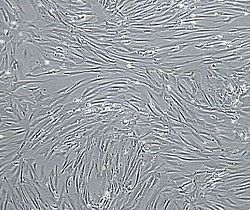Vascular smooth muscle is the type of smooth muscle that makes up most of the walls of blood vessels.
| Vascular smooth muscle | |
|---|---|

Diagram showing the location of vascular smooth muscle cells.
| |

Vascular smooth muscle cells, isolated from human aorta, growing and forming a monolayer in cell culture.
| |
| Details | |
| Part of | smooth muscle wall of blood vessels |
| Identifiers | |
| MeSH | D009131 |
| Anatomical terminology | |
Vascular smooth muscle refers to the particular type of smooth muscle found within, and composing the majority of the wall of blood vessels.
Vascular smooth muscle is innervated primarily by the sympathetic nervous system through adrenergic receptors (adrenoceptors). The three types present are: alpha-1, alpha-2 and beta-2 adrenergic receptors|. The main endogenous agonist of these cell receptors is norepinephrine (NE).
The adrenergic receptors exert opposite physiologic effects in the vascular smooth muscle under activation:
Vascular smooth muscle contracts or relaxes to change both the volume of blood vessels and the local blood pressure, a mechanism that is responsible for the redistribution of the blood within the body to areas where it is needed (i.e. areas with temporarily enhanced oxygen consumption). Thus the main function of vascular smooth muscle tone is to regulate the caliber of the blood vessels in the body. Excessive vasoconstriction leads to high blood pressure, while excessive vasodilation as in shock leads to low blood pressure.
Arteries have a great deal more smooth muscle within their walls than veins, thus their greater wall thickness. This is because they have to carry pumped blood away from the heart to all the organs and tissues that need the oxygenated blood. The endothelial lining of each is similar.
Excessive proliferation of vascular smooth muscle cells contributes to the progression of pathological conditions, such as vascular inflammation, plaque formation, atherosclerosis, restenosis, and pulmonary hypertension.[1][2] Recent studies have shown that the majority of cells within atherosclerotic plaque, the predominant cause of heart attack and stroke, are vascular smooth muscle cell derived.[3]